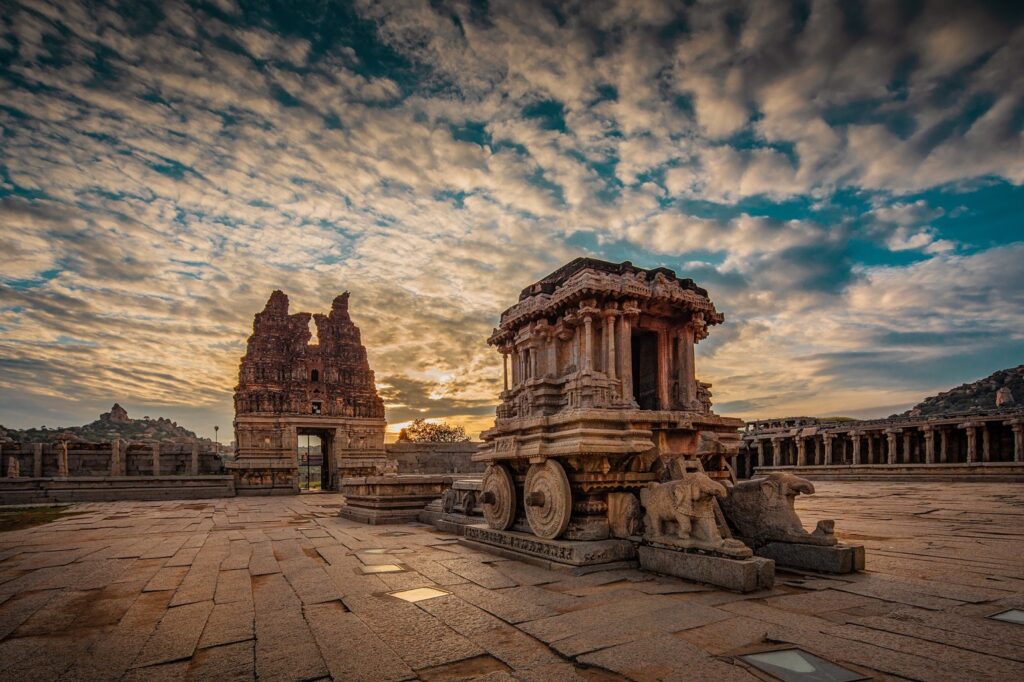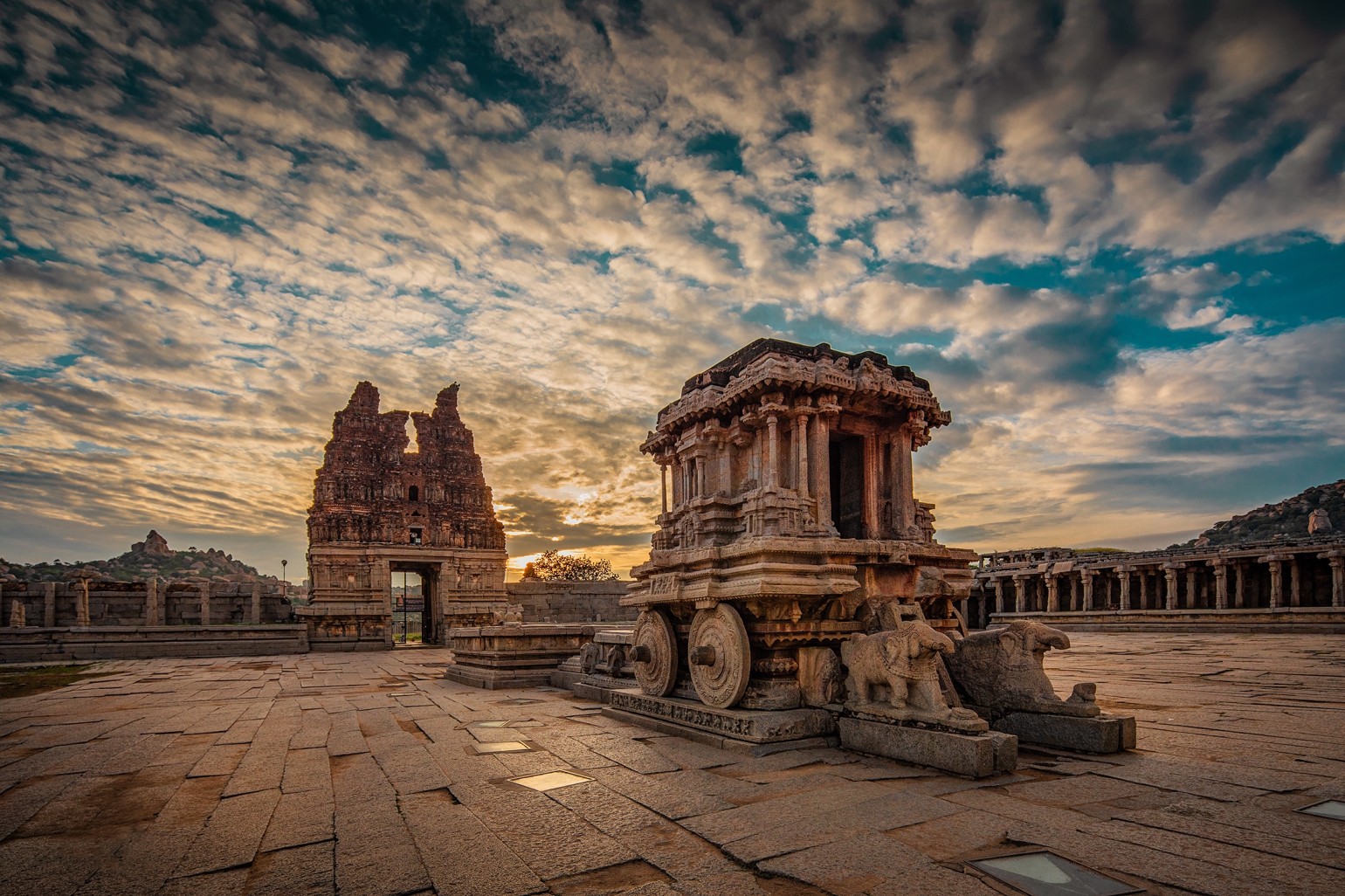Hampi, a small town in Karnataka, South India, is a treasure trove of history and culture. Once the prosperous capital of the Vijayanagara Empire, it is now home to over 1,600 ancient ruins spread across a sprawling, rocky landscape. Declared a UNESCO World Heritage Site, Hampi offers a unique blend of history, spirituality, and adventure, making it a must-visit for travelers seeking an offbeat experience.

Where to Stay in Hampi
- Hospet: A convenient base for those arriving by train, Hospet offers a range of hotels but lacks the scenic charm of Hampi.
- Hampi Bazaar: Staying in the heart of Hampi gives you quick access to major attractions. However, be aware that ongoing disputes between hotel owners and local authorities may impact availability.
- Virupapur Gaddi: The most tranquil option, Virupapur Gaddi is accessible via a short boat ride. It’s ideal for those looking to stay amidst nature. Recommended homestays include Srinivasa Homestay, Arjun Homestay, and Vinayaka Homestay.
Where to Eat in Hampi
- Mango Tree (Hampi Bazaar): A traveler’s favorite offering delicious thalis in a peaceful setting surrounded by banana plantations.
- Suresh Restaurant (Hampi Bazaar): Known for its homemade pasta and budget-friendly menu.
- Um Café (Virupapur Gaddi): A laid-back spot with a great rooftop view, perfect for unwinding with a cup of chai.
When to Visit
The best time to visit Hampi is between October and March, when the weather is cooler and ideal for sightseeing. Avoid visiting during the monsoon season (June to September) as heavy rains can make some ruins inaccessible.
Festivals to Experience:
Purandara Festival (January/February): A classical music festival featuring performances that pay homage to the legendary composer Purandara Dasa—a must-see for music lovers.
Vijaya Utsav (November): A vibrant celebration showcasing traditional music, dance, and colorful processions, highlighting the region’s rich cultural heritage.
3-day Itinerary
Day 1: Discover the Tranquility of Virupapur Gaddi & Anegundi
Start your journey by exploring the quieter side of Hampi across the Tungabhadra River, known as Virupapur Gaddi. A short boat ride from Hampi Bazaar takes you to this serene region, where lush green fields and ancient ruins await.
Anegundi Village: Begin your day by visiting Anegundi, a charming village often overlooked by tourists. The Kishkinda Trust, a local NGO, has been working to promote sustainable tourism here. Take a leisurely stroll through the village, admire the traditional architecture, and soak in the tranquil rural landscape dotted with rice paddies and palm trees.
Durga & Monkey Temples: Next, head to the Durga and Monkey temples, both situated on hilltops offering panoramic views of Hampi. The climb up the steps is a bit of a workout, but the stunning vistas of the boulder-strewn landscape are worth the effort. The Monkey Temple, believed to be the birthplace of Lord Hanuman, is particularly revered by pilgrims.
Sanapur Lake: End your day at Sanapur Lake, a hidden gem surrounded by boulders and hills. The calm waters reflect the setting sun, creating a picturesque end to your first day in Hampi. You can even take a coracle boat ride or simply relax by the shore.
Day 2: Immerse Yourself in the Heart of Hampi by Tuk-Tuk
On your second day, explore the bustling Virupaksha side of Hampi, which is home to many of the main attractions. Given the expansive area and harsh sun, hiring a tuk-tuk is a convenient way to visit these sites.
Vittala Temple & Stone Chariot: Begin early with a visit to the Vittala Temple, famous for its magnificent stone chariot. The temple’s musical pillars and exquisite carvings showcase the architectural brilliance of the Vijayanagara era. While it’s a 2-kilometer walk from the entrance, the beauty of the temple complex makes it worth the effort. There is also an option to take a shared tourist van if you prefer not to walk.
Royal Enclosure & Hazara Rama Temple: Continue your day at the Royal Enclosure, where you’ll find the Lotus Mahal, Elephant Stables, and the Queen’s Bath. These structures, blending Islamic and Hindu architectural styles, give a glimpse into the opulence of the Vijayanagara court. Don’t miss the Hazara Rama Temple, adorned with intricate bas-reliefs depicting scenes from the Ramayana.
Laxmi Narasimha & Underground Shiva Temple: Pay a visit to the massive statue of Laxmi Narasimha, a half-man, half-lion incarnation of Lord Vishnu. Nearby, explore the intriguing Underground Shiva Temple, which often has its sanctum submerged in water.
Day 3: Exploring Hampi on Foot
After two days of intense exploration, spend your final day on foot, wandering through some of Hampi’s most iconic sites.
Virupaksha Temple: Start your morning at the Virupaksha Temple, dedicated to Lord Shiva. This functioning temple is the spiritual center of Hampi and draws both tourists and pilgrims. Arrive early to witness the morning rituals and see Laxmi, the temple elephant, being bathed in the river.
Monolithic Ganesha Statues: Just behind the temple are the Sasivekalu and Kadalekalu Ganesha statues. These giant monolithic sculptures are dedicated to the beloved elephant-headed deity and provide excellent photo opportunities.
Hemakuta Hill & Matanga Hill: Climb up Hemakuta Hill for a bird’s-eye view of the Virupaksha Temple and the sprawling ruins of Hampi. Later, head to Matanga Hill for a sunset hike, where you’ll be rewarded with breathtaking panoramic views of the boulder-strewn landscape and the Tungabhadra River.
Getting to Hampi
- By Train: The nearest station is in Hospet, which has direct connections to major cities like Bangalore and Goa.
- By Bus: Several overnight buses run from Bangalore and Goa to Hospet. From Hospet, it’s a 15-minute rickshaw ride to Hampi.
- By Air: The nearest airport is in Hubli, about 4 hours away by car.
Travel Tips for Hampi
- What to Pack: Bring comfortable walking shoes, sun protection, and mosquito repellent. Don’t forget a reusable water bottle to stay hydrated.
- Safety: While Hampi is generally safe, avoid venturing out alone at night due to the presence of snakes and sloth bears in the rocky terrain.
- Sustainable Travel: Support local businesses, minimize waste, and respect local customs and traditions.
Pay Like a Local in Hampi Using the Mony App
One of the best ways to truly immerse yourself in a destination is to experience it like a local, and that includes making payments with ease. With the Mony App, international tourists can now enjoy seamless transactions just like locals do. Whether you’re paying for a delicious thali at a roadside café, buying a handcrafted souvenir at the Hampi Bazaar, or tipping your tuk-tuk driver, the Mony App allows you to pay directly using UPI (Unified Payments Interface). It’s quick, convenient, and widely accepted across Hampi, making your travel experience smoother. So, while you explore the ancient ruins and breathtaking landscapes, let Mony App take care of your payments, ensuring you have more time to enjoy the magic of Hampi!

